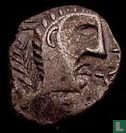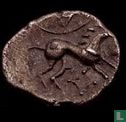

Enlarge image


Catalogue information
LastDodo number
5848205
Area
Coins
Title
Ancient Celts (Iceni tribe) AR unit ca 45-65
Country
Face value
Year
55
Variety / overstrike
Era
Head of State
Type
Designer
Series
Theme
Material
Gold- or silver content
Weight
0.99
Diameter
Thickness
Punch
Shape
Obverse
( Queen Boudicca )
Reverse
(horse)
Edge
Privy mark
Mint mark
Number produced
Krause and Mishler number
Catalogue number
Hobbs 3595, Van Arsdell 790-1, Seaby 434
Details
The Iceni tribe lived in
the Eastern UK near Norwich.
"In stature she was very tall, in appearance most terrifying, in the glance of her eye most fierce, and her voice was harsh; a great mass of the tawniest hair fell to her hips".
- Cassius Dio, Roman historian
These words were written about Queen Boudicca, one of Britain's greatest freedom fighter heroines who rebelled against the Roman government.
During 60 or 61 AD, while the current Roman Governor Gaius Suetonius Paulinus, was leading a campaign against the island of Monain, the Iceni conspired with their neighbours the Trinovantes, amongst others, to revolt against the Romans.
Boudicca was chosen as their leader who was already passionate about protecting her tribe, territory and people due to the Romans taking her late husband Prastugus's wealth, kingdom and for the rape and torture of herself and two daughters. In Tactius's own words "Kingdom and household alike were plundered like prizes of war...."
Boudicca's and Paulinius's army movements attacked Camulodunum (now called Colchester) which was the where the Romans had their main center of rule. Archaeological evidence done by historians reveals that the city of Camulodunum was burnt to the ground in a methodical way which reveals to present historians that Boudicca was an intelligible and calculated warrior and leader who planned her attacks and succeeded in such a way that often there were no survivors.
The rebel’s next assault was on the largest, booming city in Britain called Londinium (now London), where 25,000 inhabitants who had not fled already were killed. Archaeology done recently by historians also once again shows a thick red layer of burnt debris covering coins and pottery dating before 60 AD within the bounds of the Roman city which shows the true extent the destruction caused.
By now news of the rebellion had long reached Suetonius who had abandoned Londinium strategically and was now gathering no haste in assembling his troops. With 2 Roman cities destroyed Boudicca and her army then marched on to Verulamium (now St.Albans), which was a city largely populated by Britons who had cooperated with the Romans. However since they associated with the Romans they were seen as a threat to the rebel army and the inhabitants of Verulamium were thus killed as their city was destroyed. Boudicca's desire for a country free of Romans was fast becoming a reality, or so she sadly thought.



